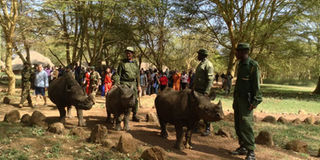The bloodhounds of the Lewa

Staff, rangers, tourists, and guides at the Lewa Wildlife Conservancy walk in solidarity of the black rhino during the commemoration of International Rhino Day on September 22, 2014, in Laikipia County. FILE PHOTO | JAMES NGUNJIRI | NATION MEDIA GROUP
What you need to know:
- The conservancy is home to some of Africa’s most endangered species: both black and white rhinos, and the Grevy’s zebra. And it has a plethora of other wildlife, including elephants, giraffes, buffalos, antelopes, lions, cheetahs and leopards
- Their expert training focuses on their incredible scent-following abilities – they are not attack dogs. This immediately became clear as “Tipper” and “Tony”, the three-year-old littermates, came right up to greet us with their floppy ears and slobbering jowls
- The unit commander told me that the dogs have also been flown across the country to assist with other cases, including trailing suspected Al-Shabaab militants
This last August, I was lucky to be part of an EcoTraining safari guide course on the Lewa Wildlife Conservancy, on the northern foothills of Mount Kenya.
The conservancy is home to some of Africa’s most endangered species: both black and white rhinos, and the Grevy’s zebra. And it has a plethora of other wildlife, including elephants, giraffes, buffalos, antelopes, lions, cheetahs and leopards.
Spending nearly a month on this world famous reserve allowed us to go well beyond the typical course material and activities. And it’s one of those behind-the-scenes aspects of the Lewa conservation effort that I want to talk about.
Lewa employs an expert response team that helps secure the conservancy and, in particular, the invaluable rhino population that is under constant threat from poachers.
These Lewa guys have undergone special military force training, and they have Kenya Police Reservist status. However, arguably their biggest asset is their special relationship with two bloodhounds.
AMAZING ANIMALS
We were camping on the periphery of the Lewa headquarters and, occasionally, we heard the distinctive howl of the dogs when they were not in the field. It took three weeks, but we eventually got to meet the team and the amazing animals.
They need daily exercise and training when not on deployment; and guests at Lewa have the opportunity to be part of these experiences. Not only do you get to learn about their role, but it helps to keep their noses sharp!
We reported to the Lewa Airstrip at 8 a.m. to find a neat line of camo-clad rangers, standing to attention. The two bloodhounds were sitting in the back of a nearby Landcruiser. A handler went over and let the dogs jump out.
Their expert training focuses on their incredible scent-following abilities – they are not attack dogs. This immediately became clear as “Tipper” and “Tony”, the three-year-old littermates, came right up to greet us with their floppy ears and slobbering jowls.
The rangers gave us a thorough breakdown of the dogs’ roles and how they are proving invaluable in their law enforcement efforts. To set the dog on the correct trail, a suspect’s scent is gathered on fresh gauze, whether it is from a footprint, a piece of clothing, or even an object that has been handled.
The handler takes care not to contaminate the gauze with their own scent by reading the wind direction and using a plastic glove.
After holding the gauze to the dog’s nose for a few seconds, he signals that the hunt is on. Off they go. These dogs love nothing more than following a trail.
CONFUSING TRAIL
As part of training, and to demonstrate their prowess, I was asked to accompany two rangers and disappear into the grassland. One of the dogs was going to try and find me by following my scent, gleaned from one of my footprints.
We hid in a shallow valley a few hundred metres away from the airstrip. On my way there I tried my best to leave a confusing trail by walking in circles, climbing and jumping off a termite mound, and even relieving myself in bushes well away from our final location.
Yes, the distance was nothing compared to a typical trail (these dogs have followed scent all the way to Isiolo, working in relays), but the dog found us within minutes of starting. He gave the two rangers and me a good sniff – before indicating that I was the actual suspect.
Fortunately, he did this by only playfully jumping on me. As a reward, I got my hand covered in slobber as I fed him some treats. Their efficiency was staggering.
These tracker dogs are famous across the region and, as a result of their successes, crime has dropped in the surrounding communities. Despite their primary anti-poaching role, the dogs are sometimes scrambled to assist with various crime investigations in the surrounding areas.
CATTLE RUSTLING
The unit also works closely with the Northern Rangelands Trust that facilitates community conservancies well into Northern Kenya. With poaching and cattle rustling common problems blighting these areas, these bloodhounds have been used to track down suspects and stolen cattle.
The unit commander told me that the dogs have also been flown across the country to assist with other cases, including trailing suspected Al-Shabaab militants.
In the end, these incredible dogs, their specialist human handlers, and the Lewa security team, carry out numerous roles and activities, whether it is anti-poaching, general law enforcement, community-supported conservation, and even showing off as a tourist attraction. They are a national asset.
May they keep up the great work.





